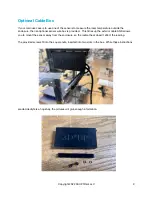
VOC Sensor Calibration
Warning: Do not place touchscreen in direct sunlight! It is designed to be used indoors.
You can calibrate outdoors as long as its in the shade.
The button in the middle is the air quality reading from the SGP30 air quality sensor board,
which measures TVOC (total volatile organic compound). Typically we see values of up to 500
ppb (parts per billion) inside an enclosure when printing ABS and half that when printing PLA
depending on the particular brand of filament.
The VOC sensor uses a MOS (Metal Oxide Semiconductor) sensor to track VOC levels. A MOS
sensor is a small metal plate coated in various materials which allow it to attract or repel
specific types of molecules. A constant charge is applied to one side of the MOS plate, and the
resulting resistance is read on the other side. Resistance temporarily increases as molecules
bounce o
ff
the plate, and this change in resistance is logged and fed into an algorithm to
calculate the VOC parts per million.
When you start the touchscreen for the first time, the VOC sensor will go into calibration mode
for 12 hours and assume that the surrounding air is a clean baseline, i.e., no 3D printing, laser
cutting, or other air pollutants. Why is the first 12-hour calibration necessary? The first time
your device is powered on, it has no preexisting baseline, so it must find one. Because each
sensor has atomic-level di
ff
erences due to the manufacturing processes, each has a unique
baseline resistance. Running the sensor for 12 hours initially allows it to come into contact with
ordinarily occurring VOCs (and other molecules regularly found in its environment). So it will not
register those molecules as VOCs when logging begins.
VOC Sensor Recalibration
Why might be recalibration necessary? Over time, as molecules bounce o
ff
the MOS plate, the
coating slowly degrades, and molecules may become 'stuck' to the plate. The molecules
gradually increase the resistance by sticking to the MOS plate, which reduces sensor accuracy.
To counteract this, recalibration is occasionally required. By recalibrating the VOC sensor, a
new baseline will be created, and all future values will be compared to that baseline and
adjusted accordingly. Recalibration should only be run while the air is as VOC-free as possible.
To recalibrate the sensor, go to the Info Page (press the 'i' in the top-right of the screen), and
then press the "Recalibrate" button - it should flash green. For the next 12 hours, the main
page's VOC button will display "Calibrating."
Copyright 2022 3D UPfitters LLC
7





























